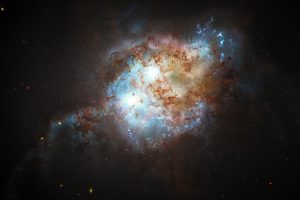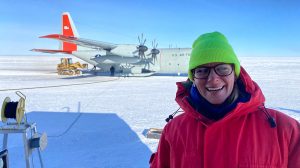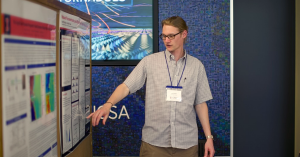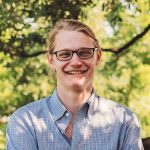May 31, 2023 — While NCSA’s main building has been sitting just off the North Engineering quad for decades, and the originally funded NSF Center has been an integral part of the University of Illinois Urbana-Champaign since its creation, there may be aspects to the Center’s offerings that students aren’t yet aware of.
 NCSA has a number of collaborations and partnerships that offer opportunities for students to gain valuable experience and to be a part of important research. The Center for Astrophysical Surveys (CAPS) is just one of the robust collaborations with NCSA, U of I Physics and Astronomy that provides students with distinctive opportunities right here on campus.
NCSA has a number of collaborations and partnerships that offer opportunities for students to gain valuable experience and to be a part of important research. The Center for Astrophysical Surveys (CAPS) is just one of the robust collaborations with NCSA, U of I Physics and Astronomy that provides students with distinctive opportunities right here on campus.
Students who are awarded a CAPS fellowship are given a stipend, paid tuition, access to NCSA computing resources and travel funds for CAPS and NCSA-related work. But perhaps the most important aspect of the fellowship is its focus on research. While many fellowship programs give fellows the opportunity to focus on the research that inspires and interests them, CAPS fellows are afforded the unique opportunity to be an integral part of important projects while utilizing one-of-a-kind resources at NCSA. CAPS fellows have accomplished a great deal since the start of the program just three years ago including discovering quasars and traveling to the South Pole. Here are just a few of the many success stories that show how brightly CAPS fellows shine.
Fiery Double Quasars Discovery
NASA’s storied Hubble Space Telescope has seen a lot of things since its launch in 1990. Despite being in orbit around the Earth since then, there are still some celestial objects rarely seen in images from Hubble. Recently, a team of researchers led by Yu-Ching Chen, a former CAPS fellow and current graduate student at UIUC, identified a pair of gravitational bound quasars with the help of the clear images Hubble provided.

Quasars are the bright objects created by supermassive black holes – those so large, they can drag entire galaxies toward them. As gas is pulled into the black hole, it creates friction, which results in a luminous display that can be seen across the universe. Quasars can be more brilliant than a whole galaxy. The quasars found by Chen and his colleagues existed when the universe was only 3 billion years old.
“We don’t see a lot of double quasars at this early time in the universe, and that’s why this discovery is so exciting,” Chen said. He’s the lead author of the study that was eventually published in Nature, one of the most exclusive scientific journals in academics.

Chen’s work could end up answering a number of questions astronomers have about black holes and their formation. “Knowing about the progenitor population of black holes will eventually tell us about the emergence of supermassive black holes in the early universe, and how frequent those mergers could be,” said Chen.
Chen was a graduate student fellow in 2020-2021. His stipend from this time helped support him when he was conducting parts of his analysis on this work.
“Being a CAPS Fellow was a wonderful experience in my Ph.D. journey. The computing resources and facilities at NCSA provided me with the necessary tools to successfully conduct the proposed projects. Additionally, collaborating and engaging with other CAPS Fellows and faculty members sparked new ideas and perspectives,” said Chen.
You can read more about Chen’s work on this research here.
A Journey to the South Pole
CAPS fellow Melanie Archipley was lucky enough to have one of the most unique experiences an astronomer can have. When she was chosen for a rotation working at the South Pole Telescope (SPT) she was excited for the opportunity. She’s been studying SPT data ever since she began as a student. Being able to go see the SPT in person was truly something special. “It was so magical to finally see the telescope,” she said. “My background is in astrophysics. I’m studying the galaxies. It was a unique opportunity for me to get in touch with the engineering side of the telescope.”

Her adventure at the South Pole brought her new insights into how this data is collected. She spent two months in one of the harshest environments on earth, and every day was an experience she won’t soon forget. “It really feels like a completely different life,” Archipley said. “For people that have a couple of months where they’re thinking, where do I want to go next? Then you should definitely go because there’s nothing else like it.”

“The CAPS fellowship has boosted my graduate research in every dimension: I’ve gained tools, knowledge, connections, and confidence as a result of the fellowship. In particular, the CAPS computing resources have significantly improved my research effectiveness, and I’m so grateful for all the opportunities from CAPS,” she said.
CAPS has given Archipley the chance to explore her passion in more ways than one. Archipley’s experience working in Antarctica is paired with a robust research program she’s taken advantage of as well.
You can read more about Archipley’s journey to the South Pole here.
A Promising Start to an Eventful Career
Going to college is the first step in what most students hope will be a fruitful career. To get the best positions, students need to stand out in some exceptional way to be considered. Fellowships like CAPS don’t just provide evidence of this exceptionalism, they offer opportunities to work on projects with mentors already employed in the field, giving students real-world experience they can speak to when they start interviewing in their last year of school.

Former CAPS fellow, Scott Perkins, graduated in 2022. Before he graduated, he landed a post-doctoral position at one of the most prestigious research institutions in the United States, Lawrence Livermore National Lab (LLNL). Perkins was excited about starting off his career with such a distinguished research lab. “The type of work they do is very computationally/statistics focused, which are huge passions of mine,” he said. “I’ll still be doing work on fundamental physics focused on exploring possible explanations of dark matter, but in a context that will allow me to use new and exciting statistics techniques that I didn’t have an outlet to explore previously.”

Perkins was also well aware that being in a national lab of LLNL’s caliber would keep him on track to further expand his experience. “Working at a national lab can give me lots of opportunities to explore other fields of science. I would love to work on topics outside of astronomy and astrophysics as well, and the lab is structured such that I can do just that.”
“UIUC and NCSA helped to provide the infrastructure for my research. Much of my focus has centered around computational sciences. Through the campus cluster and NCSA resources, I’ve been able to dive into that field very effectively. I’ve very much benefited from seminars and lectures hosted by UIUC and the NCSA, exposing me to all kinds of cool science,” Perkins said.
You can read more about this story here.
If you’re interested in a CAPS fellowship, and taking advantage of all the opportunities and resources available to CAPS fellows, you can find out more information about the CAPS program and how to apply here.
Source: Megan Meave Johnson, NCSA



























































